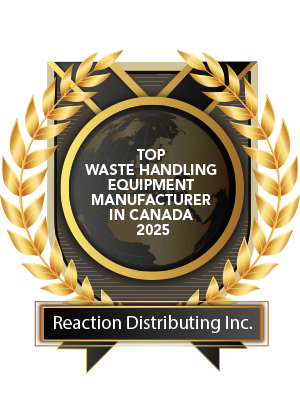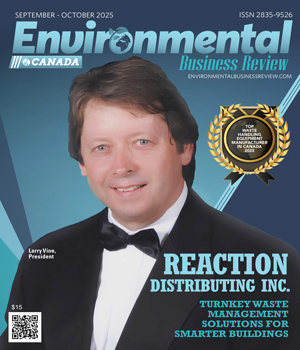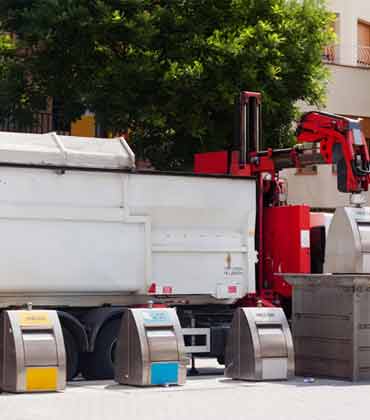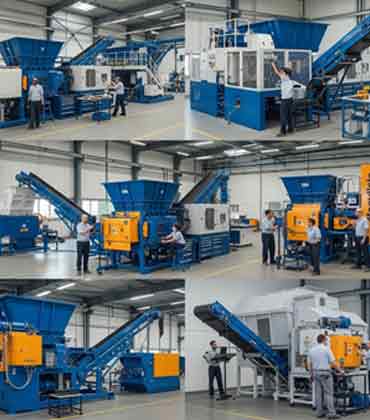Thank you for Subscribing to Environmental Business Review Weekly Brief
Environmental Business Review: Specials Magazine
Reaction Distributing Inc. (RDI) engineers high-performance waste management systems that integrate precisely with architectural specifications, adapt to complex site conditions and optimize operational efficiency. For contractors, developers and architects, this means fewer design conflicts, smoother installations, safer operations and long-term savings through reduced labor and maintenance. Its tailored approach has made the company a trusted partner for some of Canada’s most complex infrastructure projects, including high-rise condominiums and hospitals. RDI’s fully integrated waste management equipment works seamlessly with the building and its occupants. “We embrace out-of-the-box thinking to create turnkey solid waste handling solutions,” says Larry Vine, president. RDI’s success is driven by its dedication to engineering. In-house engineers create shop drawings that lay the foundation of every project. Rendered in 3D, these drawings give clients a clear picture of the equipment’s appearance upon completion. The process drives value and delivers effective waste management solutions that fit client needs. Driving Long-Term Benefits with Early Waste Planning RDI’s business model makes it stand out in the Canadian market. Since 1993, it has designed and built waste-handling systems from the ground up. The portfolio includes wet and dry waste systems, recycling systems, roll-off containers, high-rise residential compactors, trash chutes and cart tippers. They are engineered for the site’s exact footprint, waste profile and performance goals. From high-rises to industrial hubs, its custom approach transforms waste management strategy into a long-term advantage. Its approach to each project is rooted in driving results, achieved through an elaborate two-step process of early planning and on-site refinement. In the planning stage, RDI aims to engage architects, contractors and building owners as early as possible for every project. This can happen up to four years before the launch. It also offers design support for architects and their consultants at no additional cost. The process starts with creating preliminary shop drawings based on architectural designs provided by the client. The drawings reflect systems offering the most user-friendly experience while meeting building security needs. Reducing the labor required to operate the systems is also a key focus during this stage. RDI prepares two sets; shop drawings based on architectural plans and as-built drawings. Project managers review concept designs with clients to ensure they do not conflict with other systems in the building. Once the building construction is completed, its technicians visit the site to collect the dimensions necessary to create the final set of as-built drawings. “Our process allows us to catch issues before they become problems,” says Vine.
Climate Change Solutions Provider in Canada
Environmental regulations have become essential for financial institutions, insurers and legal professionals to manage risks, maintain reputational integrity and future-proof their operations against evolving environmental standards. For ensuring compliance, clients need experienced partners like GHG Accounting Services that can help clients overcome a myriad of regulatory issues. Standing tall for nearly 20 years, the company is an expert on greenhouse gas (GHG) emissions accounting, climate change strategies and sustainability compliance. It aims to help businesses accurately measure, report and reduce their carbon footprints. The company’s dedication to sustainability is reinforced through its untarnished track record in regulatory compliance and upholding strict reporting standards while maintaining its independence by avoiding financial trading or brokering. With extensive experience in a wide range of services, the company excels in auditing, quantification, planning, and ensuring compliance with international standards. This includes expertise in science-based targets and carbon intensity (CI) calculations for fuels. “Our company leverages smart and energy-efficient technology like server-less systems to streamline data collection and management, which improves operational efficiency and minimizes effort on our clients’ part,” says Svend Andersen, CEO of GHG Accounting Services. The company helps clients with reliable and accurate environmental disclosures. Its approach is based on stringent standards and best practices to ensure that the clients’ disclosures are consistent and auditable, which prevents issues like greenwashing or legal risks. The company delivers trustworthy information for clients to use in financial planning and public communication.
Environmental Remediation Services Provider in Canada
Soil is the foundation of life. Prioritizing its role as a crucial cog in the planet’s ecosystems and food production, regulatory entities worldwide are introducing mandates for efficient and sustainable soil management. In Ontario, a market with stringent compliance needs driven by the 406/19 regulation, Essential Soils Solutions (ESS) stands out as a trailblazer in soil remediation and aggregate mining. Blending innovation and environmental responsibility, it is a forward-thinking company that minimizes waste, reduces carbon emissions, and creates long-term value for clients and the environment with a transformative approach. Operating from one of Ontario’s largest soil remediation hubs, ESS runs its facility atop the rugged Canadian Shield bedrock. This strategic location allows for year-round operations. More than a treatment center—it’s a Class 1+ soil remediation facility known for handling all soil types with operational excellence. “At our facility, we optimize efficiency by combining soil remediation with limestone aggregate mining, all within a single site. By leveraging the economies-of-scale, we can effectively reduce the construction industry’s carbon footprint,” says Matthew Cinelli, General Manager. With this integration, trucks arrive with contaminated soil, unload it for treatment, and leave with newly mined aggregates—eliminating empty trips and significantly reducing emissions and transportation costs. This innovative economies-of-scale approach streamlines project timelines while ensuring precise tracking and full compliance with provincial environmental regulations.
CXO INSIGHTS

Integrating Innovation and Practicality for Sustainable Packaging Solutions
Julia Lodi, Procurement Specialist - Packaging, Nature’s Path

Sustainable Packaging A Sustainable Business Approach
Titilope Omidiran (PhD), Global Environmental Social and Governance manager, Hunter Amenities International Ltd

Supply Chain Constraints Call for New Approach to Material Handling Equipment Fleet Management
David Horak, Vice President of Distribution, Carolina Handling

Navigating the Evolving Landscape of Construction Management
Emily Pencer, Project Manager, Roxboro Excavation Inc

Navigating the Future of Restaurant Construction
Seamus Farnan, Vice President, Construction - Store Development, Earls Kitchen + Bar
IN FOCUS
Unlocking Efficiency: Waste Handling Solutions in Canada
Waste handling equipment in Canada offers efficiency, environmental benefits, and compliance, enhancing productivity and reducing operational costs.
Smart Waste Handling Solutions: Canada's Push for Environmental Compliance and Efficiency
Canada's waste-handling solutions prioritize innovative machinery for efficiency, versatility, safety, and compliance with evolving environmental regulations.
EDITORIAL
Building a Climate-Ready Future
Tailings ponds stretch for miles, wildfires redraw summers, floods remake coastlines and landfills strain under the weight of modern consumption. What once were separate crises, remediation, waste management and climate adaptation, are now converging into a single national test. Today, remediation is no longer judged only by cleanup, but by foresight. AI models map how contaminants migrate through soil and water, while digital twins simulate decades of outcomes before a shovel ever breaks ground. Nanotechnologies and bio-based agents neutralize toxins where they lie, reducing the old cycle of moving problems from one site to another. Waste handling is undergoing the same transformation. The era of trucks and landfills is giving way to intelligent systems; sensor-equipped containers that flag contaminants in real time, modular recovery units that extract scarce metals and chemicals at the source and robotics that sort materials at industrial speed. Circular design pushes manufacturers to plan for a product’s second life before its first even begins. Carbon capture, green hydrogen and nature-based defenses now stand alongside remediation and waste innovations, creating an ecosystem of solutions that stretches from the molecular to the planetary. Driven by these benefits, the global environmental services market is projected to grow to $50.6 billion by 2028, at a CAGR of 6.3 percent. The magazine features a thought-provoking article from Lexie Bullock, Manager of Environmental Compliance Programs, Central at Air Canada, who discusses the emerging trends in aviation sustainability, including stricter emissions regulations, the rise of sustainable aviation fuels and new rules on plastics and stewardship programs. Additionally, an article by Seamus Farnan, VP of Construction, Store Development at Earls Kitchen + Bar, explores the impact of data-driven decision-making, emerging trends in restaurant design and the importance of mentorship and leadership development in career growth. The publication spotlights Reaction Distributing Inc. as the cover feature, recognizing its expertise in custom waste management solutions by designing, building and integrating systems that improve efficiency, safety and sustainability. This edition features the Waste Handling Equipment Manufacturer in Canada 2025, Environmental Remediation Services Provider in Canada and Climate Change Solutions Provider in Canada, we hope you find the right partner to meet your organization’s needs.









